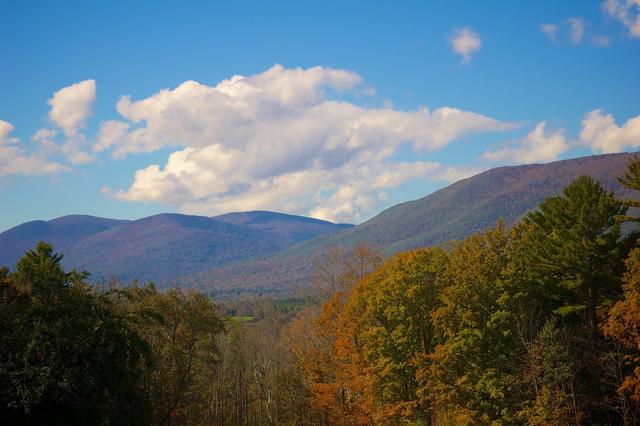Home » Regions » North America » Northern Forests » Atlantic Highlands » Northeastern Highlands » Taconic Mountains
Taconic Mountains
Last updated: August 24th, 2020
↑About the Taconic Mountains
The Taconic Mountains are a mountain range running north-south along the eastern border of New York State. This region is split between far eastern New York State, southwestern Vermont, and far western Massachussets.The mountains of this region have a sharp, rugged appearance, in spite of reaching lower elevations than the nearby Catskills and Adirondacks. Elevations range from 1,000-2,100 ft, with local relief of 600-800 ft. The underlying bedrock is mostly metamorphic rocks, with some limestone and conglomerate. This creates a landscape of low mountains and tall hills, variably gentle and steep slopes, and narrow valleys. There are few lakes, but some springs and caves due to the soluble limestone. Glacial till here is thinner than at lower elevations, and discontinuous; it tends to be mostly loamy with some sandy till.
The climate is humid and continental, with a frost-free growing season of 90-135 days. Precipitation is only slightly higher than surrounding lowland areas, and roughly equally distributed throughout the year, slightly less in winter owing primarily to the colder temperatures. Winter precipitation mostly arrives as snow. This region stretches far enough north-south that there is an appreciable climate difference between its northern and southern end, reflected in significant changes in forest type.
This region features northern hardwood forests on cooler sites at mid-to-high elevations, including sugar maple (Acer saccharum), American beech (Fagus grandifolia), American basswood (Tilia americana), and yellow birch (Betula alleghaniensis), with some eastern white pine (Pinus strobus) and eastern hemlock (Tsuga canadensis). Lower-elevation, drier slopes, especially towards the south of this region, also have some oak-hickory forest, with northern red oak (Quercus rubra), white oak (Quercus alba), chestnut oak (Quercus montana), shagbark hickory (Carya ovata), bitternut hickory (Carya cordiformis), and pignut hickory (Carya glabra). The highest elevations in the north have spruce-fir forest. In the south, the highest elevations have scrubby growth of pitch pine (Pinus rigida) and bear oak (Quercus ilicifolia).
Although nearly all of this region was logged, there are a few small, isolated old-growth forests remaining at Mount Washington State Forest in Massachusetts (not to be confused with Mount Washington, NH, a taller mountain part of a different mountain range) and the adjacent Mount Everett State Reservation.
This area is sparsely populated and only minimally utilized for agriculture, with small amounts of pasture and cropland only in the valleys. There is some forestry, hunting, and recreational use of land. Most of this region is currently covered in dense, unbroken forest.
Most of this region is bordered to the west by the Taconic Foothills, a transitional region between this region and the Hudson Valley to the west. At the center of this region, there is a small border to the west with the geologically- and ecologically-distinct Rensselaer Plateau. This region is bordered to the east by the Western New England Marble Valleys. At the far northern end, there is also a small border with the Champlain Lowlands.
 This photo shows Equinox Mountain and nearby peaks, taken from the Vermont side; this is the highest-elevation part of the Taconic Mountains. Although these mountains are lower in elevation than the Adirondacks and Catskills, they are quite rugged and steep. Photo © Shiran Pasternak, CC BY 2.0, Source.
This photo shows Equinox Mountain and nearby peaks, taken from the Vermont side; this is the highest-elevation part of the Taconic Mountains. Although these mountains are lower in elevation than the Adirondacks and Catskills, they are quite rugged and steep. Photo © Shiran Pasternak, CC BY 2.0, Source.Plant Lists & In-Region Search
We do not yet have data to generate plant lists for a region as fine-tuned as this one. However you can move up to the broader Northeastern Highlands and generate lists for that region: native plants or all plants. Or search that region's plants here:
↑References
1. Griffith, G.E., Omernik, J.M., Bryce, S.A., Royte, J., Hoar, W.D., Homer, J.W., Keirstead, D., Metzler, K.J., and Hellyer, G. "Ecoregions of New England (Poster)", U.S. Geological Survey (2009) Web.
2. Bryce, S.A., Griffith, G.E., Omernik, J.M., Edinger, G., Indrick, S., Vargas, O., and Carlson, D. "Ecoregions of New York (Poster)", U.S. Geological Survey (2010) Web.


